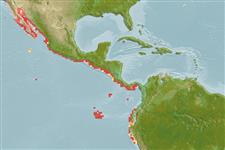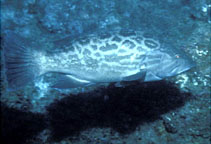Mycteroperca xenarcha Jordan, 1888
Broomtail grouper
Add your observation in Fish Watcher
| Native range | All suitable habitat | Point map | Year 2050 |

|
| This map was computer-generated and has not yet been reviewed. |
| Mycteroperca xenarcha AquaMaps Data sources: GBIF OBIS |
Upload your photos and videos
Pictures | Stamps, coins, misc. | Google imageMycteroperca xenarcha
Picture by Gotshall, D.W.
Pictures | Stamps, coins, misc. | Google imageMycteroperca xenarcha
Picture by Gotshall, D.W.
Colombia country information
Common names:
Cherna
Occurrence: native
Salinity: marine
Abundance: | Ref:
Importance: commercial | Ref: To be filled, 1997
Aquaculture: | Ref:
Regulations: | Ref:
Uses: no uses
Comments: Also Ref. 2850, 36754.
National Checklist:
Country Information: https://www.cia.gov/library/publications/resources/the-world-factbook/geos/co.html
National Fisheries Authority:
Occurrences: Occurrences Point map
Main Ref: Heemstra, P.C. and J.E. Randall, 1993
National Database:
Occurrence: native
Salinity: marine
Abundance: | Ref:
Importance: commercial | Ref: To be filled, 1997
Aquaculture: | Ref:
Regulations: | Ref:
Uses: no uses
Comments: Also Ref. 2850, 36754.
National Checklist:
Country Information: https://www.cia.gov/library/publications/resources/the-world-factbook/geos/co.html
National Fisheries Authority:
Occurrences: Occurrences Point map
Main Ref: Heemstra, P.C. and J.E. Randall, 1993
National Database:
Common names from other countries
Classification / Names Nombres comunes | Sinónimos | Catalog of Fishes(Género, Especie) | ITIS | CoL | WoRMS | Cloffa
> Perciformes/Serranoidei (Groupers) > Epinephelidae (Groupers)
Etymology: Mycteroperca: Greek, mykter, -eros = nose + Greek, perke = perch (Ref. 45335).
More on author: Jordan.
Etymology: Mycteroperca: Greek, mykter, -eros = nose + Greek, perke = perch (Ref. 45335).
More on author: Jordan.
Environment: milieu / climate zone / depth range / distribution range Ecología
marino; salobre demersal; rango de profundidad 0 - 60 m (Ref. 9342). Subtropical; 34°N - 9°S, 118°W - 79°W (Ref. 5222)
Distribución Países | Áreas FAO | Ecosistemas | Ocurrencias, apariciones | Point map | Introducciones | Faunafri
Eastern Central Pacific: San Francisco Bay, California, USA to Peru and the Galapagos Islands.
Tamaño / Peso / Age
Maturity: Lm ? range ? - ? cm
Max length : 150 cm TL macho / no sexado; (Ref. 5222); peso máximo publicado: 91.0 kg (Ref. 2850)
Max length : 150 cm TL macho / no sexado; (Ref. 5222); peso máximo publicado: 91.0 kg (Ref. 2850)
Short description Claves de identificación | Morfología | Morfometría
Espinas dorsales (total) : 11; Radios blandos dorsales (total) : 15 - 16; Espinas anales: 3; Radios blandos anales: 10 - 11. Distinguished by the following characteristics: two color patterns, first is brown blotched pattern, grey or greyish green with oblong dark blotches dorsally, forming an irregular maze-like, pale reticulum, second is plain colored pattern is uniform greyish brown, darker fins and edged with white; depth of body contained 2.9-3.1 times in SL; head length 2.6-2.8 times in SL; angular preopercle, with distinct serrate lobe at angle; posterior nostrils notably larger than anterior nostrils (Ref. 89707).
Occurs from mangrove area to over hard bottom of the continental shelf and the slope (Ref. 11035). According to Thomson et al. (1979, Ref. 6852), this species prefers mangrove estuaries. Adults and juveniles occur in shallow water with adults found to depths of 60 m.
Life cycle and mating behavior Madurez | Reproducción | Puesta | Huevos | Fecundidad | Larva
Main reference
Upload your references | Referencias | Coordinador | Colaboradores
Heemstra, P.C. and J.E. Randall, 1993. FAO Species Catalogue. Vol. 16. Groupers of the world (family Serranidae, subfamily Epinephelinae). An annotated and illustrated catalogue of the grouper, rockcod, hind, coral grouper and lyretail species known to date. Rome: FAO. FAO Fish. Synop. 125(16):382 p. (Ref. 5222)
IUCN Red List Status (Ref. 130435: Version 2024-2)
Data deficient (DD) ; Date assessed: 21 November 2016
Threat to humans
Harmless
Human uses
Pesquerías: escaso valor comercial; pesca deportiva: si
FAO(pesquerías: producción; publication : search) | FishSource | Sea Around Us
Más información
Trophic ecology
componentes alimenticios
Composición de la dieta
consumo de alimento
Food rations
Despredadores
componentes alimenticios
Composición de la dieta
consumo de alimento
Food rations
Despredadores
Population dynamics
Coeficiente del crecimiento para
Max. ages / sizes
Length-weight rel.
Length-length rel.
Length-frequencies
Mass conversion
Reclutamiento
Abundancia
Coeficiente del crecimiento para
Max. ages / sizes
Length-weight rel.
Length-length rel.
Length-frequencies
Mass conversion
Reclutamiento
Abundancia
Life cycle
Reproducción
Madurez
Fecundidad
Puesta
Spawning aggregations
Huevos
Egg development
Larva
Dinámica larvaria
Reproducción
Madurez
Fecundidad
Puesta
Spawning aggregations
Huevos
Egg development
Larva
Dinámica larvaria
Anatomy
Superficie branquial
Brain
Otolith
Superficie branquial
Brain
Otolith
Physiology
Body composition
Nutrients
Consumo del oxígeno
Tipo de natación
Velocidad de natación
Visual pigments
Fish sound
Diseases & Parasites
Toxicity (LC50s)
Body composition
Nutrients
Consumo del oxígeno
Tipo de natación
Velocidad de natación
Visual pigments
Fish sound
Diseases & Parasites
Toxicity (LC50s)
Genetics
Genética
Heterozygosity
heritabilidad
Genética
Heterozygosity
heritabilidad
Human related
Aquaculture systems
Perfiles de acuicultura
Razas
Ciguatera cases
Stamps, coins, misc.
Aquaculture systems
Perfiles de acuicultura
Razas
Ciguatera cases
Stamps, coins, misc.
Herramientas
E-book | Guía de campo | Asistente para frecuencias de tallas | Herramienta de ciclo de vida | Mapa de puntos | Classification Tree
| Catch-MSY |
Special reports
Download XML
Fuentes de Internet
Aquatic Commons | BHL | Cloffa | Websites from users | Check FishWatcher | CISTI | Catalog of Fishes(Género, Especie) | DiscoverLife | ECOTOX | Faunafri | Fishtrace | GenBank(genome, nucleotide) | GloBI | GOBASE | | Google Books | Google Scholar | Google | IGFA World Record | MitoFish | Otolith Atlas of Taiwan Fishes | PubMed | Reef Life Survey | Scirus | SeaLifeBase | Árbol de la vida | Wikipedia(Go, búsqueda) | World Records Freshwater Fishing | Zoobank | Expediente Zoológico
Estimates based on models
Preferred temperature (Ref. 115969): 19.5 - 28.6, mean 24.6 (based on 78 cells).
Phylogenetic diversity index (Ref. 82804): PD50 = 0.5000 [Uniqueness, from 0.5 = low to 2.0 = high].
Bayesian length-weight: a=0.00933 (0.00426 - 0.02047), b=3.05 (2.88 - 3.22), in cm Total Length, based on LWR estimates for this Genus-body shape (Ref. 93245).
Nivel trófico (Ref. 69278): 4.5 ±0.8 se; based on size and trophs of closest relatives
Resiliencia (Ref. 120179): Bajo, población duplicada en un tiempo mínimo de 4.5-14 años (Musick et al. 2000 (Ref. 36717)).
Fishing Vulnerability (Ref. 59153): Very high vulnerability (90 of 100).
Climate Vulnerability (Ref. 125649): Very high vulnerability (85 of 100).




